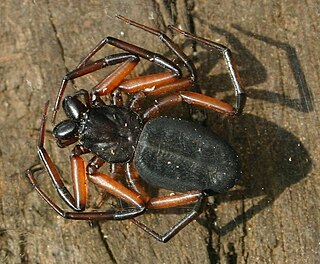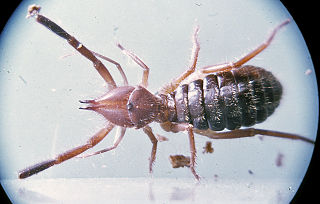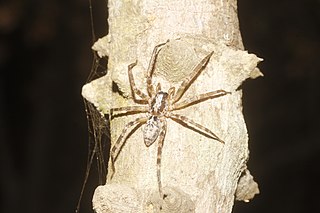
Trochanteriidae is a family of spiders first described by Ferdinand Karsch in 1879 containing about 52 species in 6 genera. Most are endemic to Australia though Doliomalus and Trochanteria are from South America and Plator is from Asia. Platyoides species exist in southern and eastern Africa, Madagascar, and the Canary Islands with one species, P. walteri, introduced to Australia.
Ferdinand Anton Franz Karsch or Karsch-Haack was a German arachnologist, entomologist and anthropologist.

Daesiidae is a family of solifugids, which are widespread in Africa and the Middle East. Members of the family are also present in India, Italy, South America, the Balkans, and the single species Gluvia dorsalis in the Iberian Peninsula. A single fossil species is known from Eocene Baltic amber.

Eremobatidae is a family of solifuges, first described by Karl Kraepelin in 1901.

Zeria is a genus of solpugid camel spiders, first described by Eugène Simon in 1879.

Acanthogonatus is a genus of South American mygalomorph spiders in the family Pycnothelidae. It was first described by Ferdinand Anton Franz Karsch in 1880. Originally placed with the brushed trapdoor spiders, it was transferred to the funnel-web trapdoor spiders in 1985, then to the Pycnothelidae in 2020.

Thaida is a genus of South American cribellate araneomorph spiders in the family Austrochilidae, first described by Ferdinand Karsch in 1880. As of April 2019 it contains only two species in Chile and Argentina.
Corinnomma is a genus of African and Asian corinnid sac spiders first described by Ferdinand Karsch in 1880.
Adcatomus is a genus of South American huntsman spiders that was first described by Ferdinand Anton Franz Karsch in 1880. As of September 2019 it contains two species, found in Peru and Venezuela: A. ciudadus and A. flavovittatus.
Pedinopistha is a genus of Hawaiian running crab spiders that was first described by Ferdinand Anton Franz Karsch in 1880.

Megalostrata is a genus of corinnid sac spiders first described by Ferdinand Karsch in 1880.

Hexisopodidae is a family of solifuges, first described by Reginald Innes Pocock in 1897.
Ceromidae is a family of solifuges, first described by Carl Friedrich Roewer in 1933.
Ceroma is a genus of ceromid camel spiders, first described by Ferdinand Karsch in 1885.
Biton is a genus of daesiid camel spiders, first described by Ferdinand Karsch in 1880.
Karschiidae is a family of solifuges, first described by Karl Kraepelin in 1899.
Hexisopus is a genus of hexisopodid camel spiders, first described by Ferdinand Karsch in 1879.
Rhagodoca is a genus of rhagodid camel spiders, first described by Carl Friedrich Roewer in 1933.
Gylippus is a genus of gylippid camel spiders, first described by Eugène Simon in 1879.
Solpugema is a genus of solpugid camel spiders, first described by Carl Friedrich Roewer in 1933.







